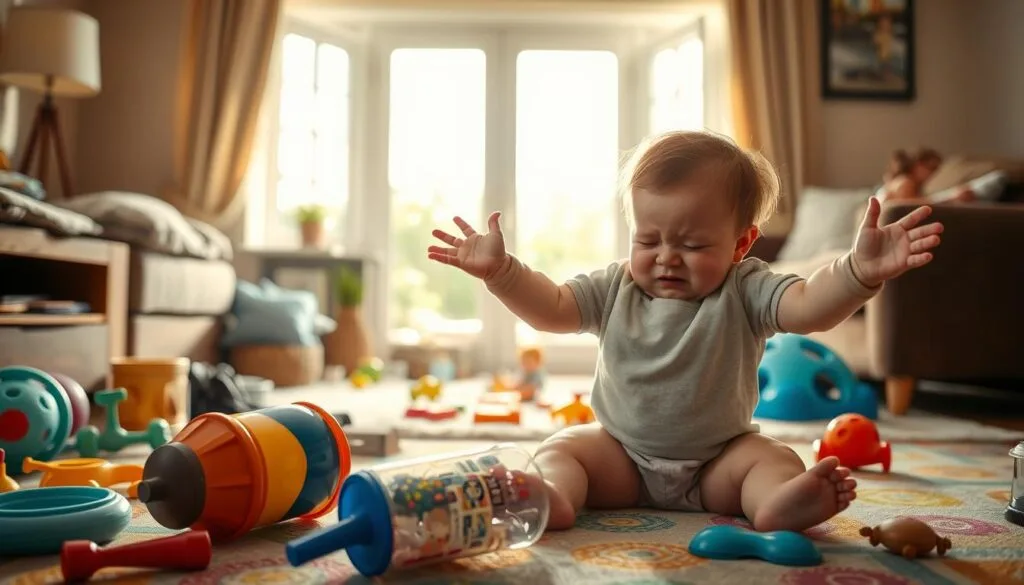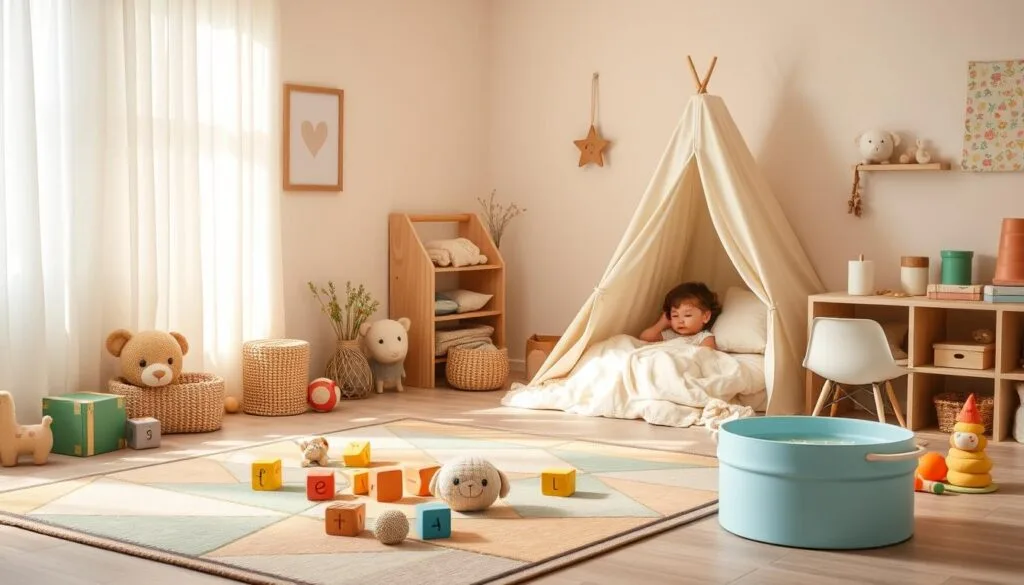
Taming Tantrums 16 Month Old Having Tantrums
Seeing your 16 month old have tantrums can be tough and worrying. But, it’s important to know that toddler tantrums are a common part of growing up. About 85% of 2- and 3-year-olds have tantrums. They usually start between 12 and 15 months, get worse between 18 and 36 months, and can last until they are about 4 years old.
Young kids often can’t express their feelings or get what they want. This leads to frustration and tantrums. As a parent, it’s vital to be patient and understanding during these times. By finding out what triggers tantrums, using calming methods, and helping with emotional growth, you can help your 16-month-old get through this tough time. This will lay a good foundation for managing behavior and improving communication skills.
Key Takeaways
- 16 Month Old Having Tantrums are a normal part of child development, with most toddlers experiencing them.
- Identifying and addressing tantrum triggers can help prevent outbursts.
- Calming techniques such as distraction and redirection can de-escalate tantrums.
- Encouraging emotional expression and using positive reinforcement can foster better communication skills.
- Patience and consistency are key in managing tantrums and promoting healthy emotional development.
Understanding Toddler Tantrums
Toddler tantrums can be tough for kids and parents. But, it’s key to know that tantrums are a normal part of growing up. Young children are learning to handle their feelings and talk about what they need. By understanding why tantrums happen, parents can help their kids during these tough moments.
Why Tantrums Happen
Tantrums happen when toddlers feel too much, get frustrated, or can’t say what they want. Some reasons include:
- Unmet needs, like hunger, thirst, or tiredness
- Feeling stuck or not getting what they want
- Struggling to share their feelings or needs
- Feeling too much from their surroundings
- Not feeling in control of their world
Toddlers aren’t trying to be naughty. Tantrums are how they deal with the world as they learn to control their feelings and actions.
Developmental Stages and Tantrums
Tantrums are most common between one and three years old. They usually get worse around 18 to 24 months. As toddlers grow, their tantrums change:
| Age | Tantrum Characteristics |
|---|---|
| 12-18 months | Tantrums start as toddlers try to be independent and can’t talk much. |
| 18-24 months | Tantrums get more common and intense as toddlers want to be on their own. |
| 24-36 months | Tantrums might lessen as kids get better at talking and expressing themselves. |
| 3-4 years | Tantrums happen less often as kids learn to handle their feelings and solve problems. |
As toddlers get older, they learn to talk, control their impulses, and manage their feelings. Knowing these stages helps parents support their kids through these tough times.
Tantrum Triggers
Toddler tantrums can be caused by many things. These include internal struggles and outside factors. Knowing what triggers tantrums is key for parents. It helps them prevent and manage these outbursts better.
Frustration and Unmet Needs
One big reason for tantrums is when toddlers feel frustrated because their needs aren’t met. This can be due to hunger, thirst, discomfort, or unmet emotional needs. A study by the National Childbirth Trust shows tantrums happen when toddlers don’t get what they want.
Overstimulation and Fatigue
Toddlers can get overwhelmed by too much around them. This includes loud noises, bright lights, and crowded places. They might get upset and throw tantrums. Also, not getting enough sleep can make them more likely to have outbursts.
| Age | Percentage of Children Experiencing Tantrums |
|---|---|
| 1 year | 50-80% |
| 2 years | 60-90% |
| 3 years | 50-80% |
Changes in Routine
Toddlers like things to be the same every day. When their routine changes, they might get upset. Keeping routines the same can make them feel safer and less likely to have tantrums.
Children don’t have tantrums deliberately; they might lack coping skills in certain situations.
By knowing what causes tantrums, parents can make their toddlers’ lives better. With patience and the right strategies, parents can help their children deal with tantrums. This way, toddlers can learn to control their feelings better.
Staying Calm During Tantrums
When your toddler throws a tantrum, it’s hard to stay calm. But, it’s key to manage the situation well. Tantrums are a normal part of growing up as they learn to handle their feelings.
It’s important not to take tantrums personally. They’re not about you or your parenting. Instead, see them as a chance to connect and help your child. By staying calm, you teach them about managing their emotions.
If you start to feel stressed, take a few deep breaths or count to ten. Sometimes, stepping away for a moment helps you stay patient. Remember, your child feels your emotions, so taking care of yourself is crucial.
“Tantrums are a chance for us to be our child’s calm center in the midst of their emotional storm.” – Dr. Laura Markham, Author of Peaceful Parent, Happy Kids
Don’t rush a tantrum or try to reason with your child when they’re upset. Instead, be there for them and let them feel their emotions. This might take longer, but it strengthens your bond and helps your child emotionally.
| Helpful Strategies | Unhelpful Responses |
|---|---|
| Taking deep breaths | Yelling or getting angry |
| Counting to ten | Taking the tantrum personally |
| Stepping away briefly | Rushing the child through the tantrum |
| Providing a supportive presence | Using sarcasm or invalidating comments |
By staying calm and showing good emotional control, you help your child now and in the future. Every tantrum is a chance for growth and connection. With patience and self-care, you can handle these tough moments with kindness and understanding.
Identifying the Root Cause
When your 16-month-old is having a tantrum, it’s hard to stay calm and figure out why. But, using empathy and problem-solving can help find the cause. Tantrums are a normal part of growing up. By being patient and understanding, you can help your child get through this tough time.
Hunger and Thirst
Hunger or thirst often leads to tantrums in young kids. A hungry or thirsty child can get very upset. To avoid these tantrums, eat regularly and keep healthy snacks ready. If you think hunger is the cause, give a nutritious snack or meal and see if it helps.
Discomfort or Pain
Discomfort, like a dirty diaper or itchy clothes, can upset toddlers. They might not know how to say they’re uncomfortable, leading to tantrums. Watch for signs of discomfort and quickly fix the problem. A diaper change, comfy clothes, or a soothing toy can help calm them down.
“When a tantrum occurs, take a moment to assess the situation and look for clues that might point to the underlying cause. Is your child rubbing their eyes or yawning? They might be tired. Are they tugging at their diaper or clothing? They could be uncomfortable.” – Dr. Elizabeth Pantley, parenting educator and author of The No-Cry Sleep Solution
Emotional Needs
Toddlers have tantrums when their emotional needs aren’t met. They might feel overwhelmed, ignored, or frustrated. Showing empathy and validating their feelings can make them feel understood. Listen to their concerns, acknowledge their feelings, and offer comfort. Meeting their emotional needs can prevent or calm many tantrums.
| Root Cause | Signs to Look For | Potential Solutions |
|---|---|---|
| Hunger/Thirst | Irritability, crying, asking for food/drink | Offer a healthy snack or drink |
| Discomfort/Pain | Tugging at clothing, diaper, or body parts | Change diaper, adjust clothing, provide comfort measures |
| Emotional Needs | Clinginess, seeking attention, frustration | Offer validation, empathy, and quality time |
Every child is different, so what works for one might not work for another. By paying attention to your toddler’s needs and using empathy and problem-solving, you can handle tantrums well. This will help you build a stronger, more understanding bond with your 16-month-old.
Effective Calming Techniques
When your toddler throws a tantrum, it’s hard to know what to do. But, using the right calming techniques can help. Toddlers can’t always say what they feel, leading to tantrums.
One great way to calm your toddler is through physical comfort. A hug, a soothing voice, or sitting with them can make them feel safe. This builds a strong bond and helps with emotional growth.
Distraction and Redirection
Try distracting your toddler with fun activities or a new place. Switching to a new toy or game can take their mind off the tantrum. This helps them calm down and prevents the tantrum from getting worse.
Offering Choices
Letting your toddler choose simple things during a tantrum can make them feel in control. Ask if they want to play with blocks or read a book. This lets them feel like they’re making decisions.
“Redirecting the child’s focus and regrouping can be effective strategies in easing tantrums and helping children navigate their emotions.”
Providing Comfort and Reassurance
Stay calm and supportive during a tantrum. Let your child know you understand their feelings. Comfort them with words and touch. This shows them it’s okay to feel strong emotions.
| Calming Technique | Benefit |
|---|---|
| Distraction and Redirection | Shifts focus away from frustration |
| Offering Choices | Promotes decision-making skills and sense of control |
| Providing Comfort and Reassurance | Offers emotional support and secure attachment |
Using these calming techniques regularly helps your toddler manage their feelings. It’s important to give them a safe space to express their emotions. This is key for their emotional growth, not being too lenient.
16 Month Old Having Tantrums
As your little one hits 16 months, you might face tantrums. It’s common for parents to see their calm baby turn into a toddler with big emotions. You’re not alone in this.
Common Behaviors and Challenges
At 16 months, your toddler is growing fast. They want to do things on their own and explore. But, they still can’t talk well, which makes them frustrated.
Some tantrum behaviors you might see include:
- Screaming and crying
- Throwing toys or objects
- Falling to the floor dramatically
- Hitting, kicking, or biting
- Refusing to cooperate or follow instructions
Handling tantrums can be tough, especially in public. Remember, tantrums are a normal part of growing up. They don’t mean you’re a bad parent.
Tantrums are not easy to deal with, but they are a normal part of a child’s development. They are how young children show that they’re upset or frustrated. – CDC
Developmental Milestones and Tantrums
At 16 months, your toddler is growing in many ways. They’re learning to walk and climb. But, they still can’t talk well, which can lead to tantrums.
Here are some developmental milestones that might cause tantrums at this age:
| Milestone | Description | Tantrum Trigger |
|---|---|---|
| Walking and climbing | Toddlers become more mobile and want to explore independently | Frustration when restricted or prevented from exploring |
| Language development | Limited vocabulary and difficulty expressing needs and wants | Inability to communicate effectively leads to frustration |
| Sense of self | Toddlers develop a stronger sense of self and desire for control | Defiance and resistance when asked to do something they don’t want to do |
To help your toddler and reduce tantrums, try these strategies:
- Teach simple signs or gestures to help them communicate their needs
- Label emotions and validate their feelings
- Offer praise and positive reinforcement when they express themselves appropriately
- Provide choices whenever possible to give them a sense of control
- Establish consistent routines and boundaries to create a predictable environment
Remember, tantrums are just a phase. With patience and understanding, you can guide your 16-month-old through this tough time.
Preventing Tantrums
Tantrums are a normal part of growing up for toddlers. Parents can take steps to reduce them. By teaching emotional intelligence and creating a structured environment, you can stop many tantrums before they start.
Establishing Routines
Creating daily routines is a great way to prevent tantrums. Toddlers like knowing what to expect. A schedule with regular times for meals, naps, and play helps them feel secure.
When you need to change the routine, tell your child ahead of time. This helps them get ready mentally and emotionally.
Communicating Expectations
Clear communication is key to avoiding tantrums. Set clear rules and boundaries for your child’s behavior. Use simple language to explain these rules and consequences.
Always follow through with consequences when needed. Praise your child for good behavior. This shows them that positive actions are valued.
“When little people are overwhelmed by big emotions, it’s our job to share our calm, not join their chaos.” – L.R. Knost
Encouraging Emotional Expression
Teach your child to express feelings in healthy ways. Encourage them to say how they feel, like “I’m frustrated” or “I’m sad.” Offer chances to express feelings through play, like with dolls or drawing.
If your child has a tantrum, acknowledge their feelings. But also set clear limits on what behavior is okay.
| Tantrum Prevention Strategy | Benefits |
|---|---|
| Establishing routines | Provides predictability and security |
| Communicating expectations | Sets clear boundaries and reinforces positive behavior |
| Encouraging emotional expression | Teaches healthy coping skills and emotional regulation |
Preventing tantrums takes patience, consistency, and empathy. By supporting emotional intelligence, you help your child deal with toddlerhood’s challenges.
Positive Reinforcement and Praise
Positive reinforcement is a key parenting strategy for shaping your toddler’s behavior. It encourages cooperative behavior by praising their efforts. For example, when they communicate calmly or share, you show them you value these actions.
Specific praise, like “I love how you used your words to ask for the toy,” works better than general praise. It helps reinforce positive behaviors more effectively.
Rewards, such as stickers or small treats, can also motivate good behavior. But, use them sparingly to avoid dependence. Praise and encouragement are more powerful for building self-esteem and lasting positive behavior.
“Praise is like sunlight to the human spirit; we cannot flower and grow without it.” – Jess Lair
Here are some tips for using positive reinforcement effectively:
- Be specific in your praise, highlighting the exact behavior you want to encourage
- Offer praise immediately after the desired behavior occurs
- Use a warm and enthusiastic tone when praising your child
- Combine verbal praise with physical affection, such as a hug or high-five
- Gradually phase out rewards as the desired behavior becomes more consistent
| Age | Positive Reinforcement Techniques |
|---|---|
| 12-18 months | Verbal praise, gentle touches, and enthusiastic facial expressions |
| 18-24 months | Specific verbal praise, small rewards (e.g., stickers), and encouraging gestures |
| 2-3 years | Detailed praise, reward charts, and privileges (e.g., choosing a special activity) |
| 3-4 years | Praise for effort and progress, tangible rewards for reaching milestones, and positive attention |
Every child is different, and what works for one may not work for another. By using positive reinforcement consistently and adjusting your approach as your child grows, you’ll help them develop important skills. These skills will help them manage their emotions and behavior effectively.
When to Seek Professional Help
Tantrums are a normal part of growing up. But, sometimes, you need to get help from a doctor or child psychologist. Knowing the red flags is key for parents.
Persistent or Severe Tantrums
If your child has tantrums often, lasts more than 15 minutes, or gets aggressive, it’s time to seek help. Violent tantrums that last over 15 minutes are a serious sign. You should talk to a healthcare provider about it.
Also, if tantrums get worse over time, it’s a red flag. Tantrums usually get better as kids get older. But, if they don’t, it might mean there’s an issue that needs attention.
Concerns About Development
Other signs that might need professional help include:
- Speech and language delays
- Sensory processing difficulties
- Social interaction challenges
- Unusual or repetitive behaviors
If you see these signs with tantrums, talk to your child’s pediatrician. They can check if your child needs to see a child psychologist or other specialist.
| Tantrum Duration | Average | Concerning |
|---|---|---|
| Typical Tantrum | 11 minutes | 25+ minutes |
| Usual Range | 2-15 minutes | 15+ minutes (violent) |
Getting professional help is not a weakness. It shows you care about your child’s well-being. Early help can really make a difference in solving problems and teaching you how to handle tough behaviors.
Offering praise for calming down can reinforce positive behavior in children.
If you’re worried about your child’s tantrums or development, talk to your pediatrician or a mental health expert. With the right support, your child can overcome challenges and thrive.
Conclusion
Managing tantrums in 16 Month Old Having Tantrums needs a positive parenting style. This style focuses on emotional growth, being consistent, patient, and supportive. Knowing why tantrums happen helps parents deal with them better.
Staying calm and figuring out the cause of the tantrum is crucial. Techniques like distraction, offering choices, and comfort help manage tantrums. These methods are key to handling outbursts effectively.
To prevent tantrums, create routines and communicate clearly. Encourage healthy ways to express feelings. When toddlers feel secure, they are less likely to throw tantrums.
Positive feedback for good behavior can also help. It reduces the number and intensity of tantrums. With patience and support, 16-month-olds can learn to handle their emotions better.
While tantrums are normal, some may need professional help. If worried about your child’s tantrums or development, talk to your pediatrician or a child development expert. Taming tantrums is a journey that needs patience and positive parenting strategies.
With love and support, you can guide your 16-month-old through this tough time. This will help them develop emotionally for years to come.















